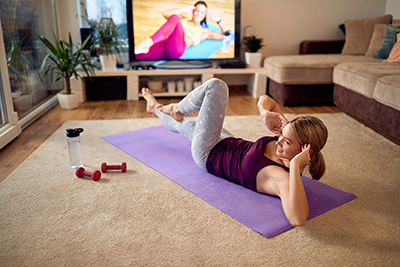Click below to listen to our Consumerpedia podcast episode on how to compare gym membership options.
With so many of us having shifted our wardrobe to yoga pants and hoodies, you’d think we’re all spending a lot of time at the gym. But according to the Centers for Disease Control and Prevention (CDC), only one in five adults gets the recommended amount of weekly physical activity.
The good news is that there are now more ways to work out than ever. Even small efforts help: Take the stairs instead of the elevator; park at the far end of the lot; take a walk before or after dinner. But a lot of newly fitness-inspired people continue to join health clubs, believing that the facilities—and the financial commitment of membership—may finally supply the motivations they need to get fit and stay fit.
Before you join a gym (or signing up for a bunch of fitness classes or buying an expensive at-home workout machine), think realistically about what activities you are likely to participate in and how often you’ll do them. If you have never exercised before, or haven’t done it in ages, will you stick to a new regimen? Most people who join fitness clubs stop using them after only a few months—but keep right on paying for a long time.
If you’re sure you want to join a club, we can help you find a good one. Our Ratings Tables list ratings of area fitness centers for quality, membership prices for sample profiles, and details on available facilities and amenities.
Some quick advice:
- Weigh all your options. Can you exercise less expensively some other way—doing pushups and crunches, running, biking, or joining a sports team? Also check out fitness centers run by local governments and YMCAs; many operate less expensive fitness club-like facilities.
- Shop around. Some clubs charge twice as much as others for about the same facilities and amenities. Because many gyms have several fee plans and discount options, make sure the sales staff offers you the best available rates. When discussing costs, mention other gyms you’re considering. And check whether you qualify for a discount based on an arrangement between the facility and your employer or health insurance plan. In particular, many Medicare Advantage policyholders have access to programs that offer free or very low-cost memberships at participating fitness centers.
- Request a guest pass to try out any club you are considering. Many gyms let you try them out for free for a few visits, or offer short-term memberships or small packages of visits to let you dip your toe into cardio/yoga/weightlifting, etc., without a big commitment. Start by taking advantage of these intro offers.
- While there, check out the cleanliness and condition of equipment. Use your pass at a time when you’re most likely to exercise regularly so you can see how crowded it gets and judge how helpful the staff is.
- Ask whether a membership you’re considering includes a time commitment. A no-commitment membership usually requires a slightly higher monthly fee, while an annual membership costs less per month. But if you’ve never joined a gym, test both your determination to exercise and the facility by going short-term or month-to-month first.
- Find out the rules for canceling any membership.
- Make a plan. Set realistic fitness goals, decide on types of exercises to achieve them, and commit to a schedule. Click here for our tips on how to make a new fitness plan and strategies that can help you stick to it. If you are older than 40, review your plan with a physician before beginning.




